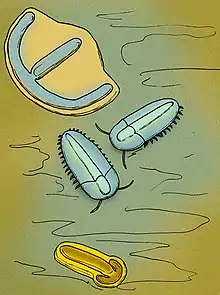| Keretsa brutoni Temporal range: Ediacaran ~ | |
|---|---|
 | |
| Artist's reconstruction of K. brutoni as an arthropod, compared to individuals of Parvancorina | |
| Scientific classification | |
| Kingdom: | |
| (unranked): | |
| Phylum: | |
| Genus: | Keretsa |
| Species: | K. brutoni |
| Binomial name | |
| Keretsa brutoni Ivantsov, 2017[2] | |
Keretsa brutoni is a fossil bilaterian from the Late Precambrian-aged Zimnie Gory Formation near Arkhangelsk Oblast, Russia, along the Winter coast of the White Sea. The first specimens were found in 2005.[2] This rounded oblong-shaped organism resembles Naraoia, in having its body divided into an anteriorly positioned headshield, and a trunkshield. A pair of antennae-like structures emanate from underneath the base of the headshield, and there are numerous oblique grooves along the trunkshield that suggest legs.[2]
References
- ↑ A.Yu. Ivantsov (2017). "The most probable Eumetazoa among late Precambrian macrofossils". Invertebrate Zoology. 14 (2): 132. doi:10.15298/invertzool.14.2.05.
The trunk axial part of Keretsa specimen is wrinkled, and we can not prove either an opposite or an alternate (as in the Proarticulata) arrangement of the half-segments.
- 1 2 3 A.Yu. Ivantsov (2017). "The most probable Eumetazoa among late Precambrian macrofossils". Invertebrate Zoology. 14 (2): 127–133. doi:10.15298/invertzool.14.2.05.
This article is issued from Wikipedia. The text is licensed under Creative Commons - Attribution - Sharealike. Additional terms may apply for the media files.